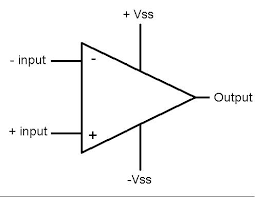Introduction:
Operational Amplifier or commonly known as op-amp is a voltage amplifying device. The output of op-amp is much much larger as compared to the potential difference between its input terminals. Operational amplifier has much importance in today’s electronic projects and it is also known as a fundamental building block of the analogue electronic circuits. Operational amplifiers were invented a long time ago and they ere also used in computers of old age. In those computers the function of operational amplifiers was to perform mathematical operations.
Operational amplifiers have a large no of applications and are most commonly use to perform some electronic operations like signal conditioning. When signals are transmitted over a long distances and what mostly happens is the strength of the signal is weakened. and some noise and disturbances are also included in it. to overcome these issues, we use repeater circuits and after some times the amplitude of signal is again boosted up with the help of operational amplifier. Similarly op-amp are also used for filtering of the signal. They are also used in logic designed projects to perform mathematical operations like addition, subtraction, integration and differentiation. The reason why operational amplifiers are much popular and are widely used in digital electronic circuits is that, they possess versatility.
Above was a little introduction about operational amplifier, its working and its applications. Now lets explain some other parameters of operational amplifiers which are given as below:
Pin configuration of operational amplifier:
Operational Amplifier has major 3 pins. Among these 3 pins, 2 pins are reserved for input and these pins are of much High Impedance. One input of the operational amplifier is known as inverted input and it is marked as negative sign (-) while the other pin of the operational amplifier is known as non-inverting input and it is marked as positive sign (+). Both these inputs have High impedance. The third terminal of the operational amplifier is its output pin and it is of Low impedance. You can also see the pin configuration of op-amp in the feature image of this tutorial.
Characteristics of an op-amp
Operational amplifier is a very important amplifier and used as a building block in various electronics projects. Op-amp possess the following features:
- The open loop gain of the differential amplifier is Infinite. Formula to calculate gain is:
G = V(out)/V(in)
Now if we are using the operational amplifier in open loop condition then, the input voltages ‘V(in)’ will becomes zero and the Gain will become infinite.
- In op-amp there is an input impedance between both terminals of the operational amplifier. In OFF condition, the value of this impedance is much HIGH and mostly it is taken as ‘infinite’. The reason to kept such a high value is to permit any current to flow between the input terminals of the op-amp.
- For a differential operational amplifier input offset voltages are kept zero. This also permits any current to flow.
- A very important feature of the operational amplifier is that we have a large no of voltage range, which can appear at the output terminal of op-amp. Since op-amp are designed to amplify the voltages up to a wider value, that’s why we can say that infinite values of voltages are available at output terminal of operational amplifier.
- When AC voltages are applied at its input terminals then, op-amp is capable to perform zero shift. Reason is that in electrical, we have various instrument like Transformer, which gives us the phase shift at output voltages. And the output voltages possess a different phase angle as compared to input voltages.
- Operational amplifier have no impedance connected to its output terminals and we can say that it has zero or negligible impedance.
- The operation of op-amp is without any kind of noise. The operation of op-amp is noise proof and no problems occurs during its operation.
Operation of Op-Amp:
Operational amplifiers have 2 differential inputs which are named as ‘Inverting’ and ‘non-inverting’ inputs. In actual case the operational amplifier only amplifies those inputs difference which is applied between its input terminals. The output generated at its terminals can be calculated by the formula given below:
V(out) = G(o.l) {(V+)-(V-)}
- In the above formula you can see that V(out) represents the output voltages which appears at the output terminal of operational amplifier.
- G(o.l) is the open loop gain of the operational amplifier.
- V+ are the voltages applied to the non-inverting input of op-amp.
- V- are the voltages applied to the inverting input of op-amp. Generally ground is connected at this pin.
Applications of Operational Amplifier
Operational Amplifiers have a large no. of applications and some of them are given below as:
- Operational amplifiers are widely used in designing of basic and also advanced electronic projects. The use of operational amplifier as a building block in various projects allows us to get our output much pure and cleaner. The word cleaner emphasis on the part that the other circuit elements like resistance, capacitance, inductance etc, effects the output of the circuit and they also distort it.
- The biggest application of the operational amplifier is ‘voltage comparator’. In order to use op-amp as a comparator, we design a circuit without any feedback. To use op-amp as a comparator gives us the opportunity to get wider range of output voltages and also state switching is done in a faster way, which means it can go from ON to OFF state within no time.
- Op-amp can also be used to design a level detection circuit in terms of voltages. For example if you connect the input or the reference voltages of the circuit to one of the input of the op-amp then, it will start behaving as an voltage level detection circuit.
- Op-amp are commonly used in radio transmission circuits. They are able to amplify the output many times, that’s why they are preferred for signal transmission.
- Op-amp have wide applications in digital electronics and are commonly used to design filter circuits, differential amplifiers and some integration based circuits.
- Op-amp are also commonly use to design ADC (analog to digital converters) and also DAC (digital to analog converters).
- Op-amp are used as a major element in designing voltage clamping circuits and oscillators.
- An interesting application of op-amp is that they are also used to design analogue calculators and some similar electronic products.











Post Comment
You must be logged in to post a comment.